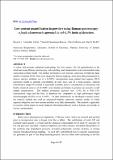Low-content quantification in powders using Raman spectroscopy: a facile chemometric approach to sub 0.1% limits of detection.

View/
Date
2015-02-23Author
Li, Boyan
Calvet, Amandine
Ryder, Alan G.
Casamayou-Boucau, Yannick
Morris, Cheryl
Metadata
Show full item recordUsage
This item's downloads: 743 (view details)
Cited 28 times in Scopus (view citations)
Recommended Citation
Li, B.; Calvet, A.; Casamayou-Boucau, Y.; Morris, C.; Ryder, A.G. (2015) 'Low-content quantification in powders using Raman spectroscopy: a facile chemometric approach to sub 0.1% limits of detection'. Analytical Chemistry, 87 (6):3419-3428.
Published Version
Abstract
A robust and accurate analytical methodology for low-content (<0.1%) quantification in the
solid-state using Raman spectroscopy, sub-sampling, and chemometrics was demonstrated using
a piracetam–proline model. The method involved a 5-step process: collection of relatively large
number of spectra (8410) from each sample by Raman mapping, meticulous data pretreatment to
remove spectral artefacts, use of a 0–100% concentration range partial least squares (PLS)
regression model to estimate concentration at each pixel, use of a more-accurate, reduced
concentration range PLS model to accurately calculate analyte concentration at each pixel, and
finally statistical analysis of all 8000+ concentration predictions to produce an accurate overall
sample concentration. The relative prediction accuracy was ~2.4% for a 0.05~1.0%
concentration range and the limit of detection was comparable to high performance liquid
chromatography (0.03% versus 0.041%). For data pretreatment, we developed a unique cosmic
ray removal method and used an automated baseline correction method, neither of which
required subjective user intervention and thus were fully automatable. The method is applicable
to systems, which cannot be easily analyzed chromatographically such as hydrate, polymorph, or
solvate contamination.

